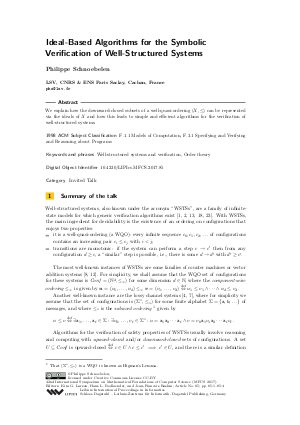Ideal-Based Algorithms for the Symbolic Verification of Well-Structured Systems (Invited Talk)
Author Philippe Schnoebelen
-
Part of:
Volume:
42nd International Symposium on Mathematical Foundations of Computer Science (MFCS 2017)
Part of: Series: Leibniz International Proceedings in Informatics (LIPIcs)
Part of: Conference: Mathematical Foundations of Computer Science (MFCS) - License:
 Creative Commons Attribution 3.0 Unported license
Creative Commons Attribution 3.0 Unported license
- Publication Date: 2017-12-01
File

PDF
LIPIcs.MFCS.2017.85.pdf
- Filesize: 345 kB
- 4 pages
Document Identifiers
Subject Classification
Keywords
- Well-structured systems and verification
- Order theory
Metrics
- Access Statistics
-
Total Accesses (updated on a weekly basis)
0Document
0Metadata
Abstract
We explain how the downward-closed subsets of a well-quasi-ordering (X,\leq) can be represented via the ideals of X and how this leads to simple and efficient algorithms for the verification of well-structured systems.
Cite As Get BibTex
Philippe Schnoebelen. Ideal-Based Algorithms for the Symbolic Verification of Well-Structured Systems (Invited Talk). In 42nd International Symposium on Mathematical Foundations of Computer Science (MFCS 2017). Leibniz International Proceedings in Informatics (LIPIcs), Volume 83, pp. 85:1-85:4, Schloss Dagstuhl – Leibniz-Zentrum für Informatik (2017)
https://doi.org/10.4230/LIPIcs.MFCS.2017.85
BibTex
@InProceedings{schnoebelen:LIPIcs.MFCS.2017.85,
author = {Schnoebelen, Philippe},
title = {{Ideal-Based Algorithms for the Symbolic Verification of Well-Structured Systems}},
booktitle = {42nd International Symposium on Mathematical Foundations of Computer Science (MFCS 2017)},
pages = {85:1--85:4},
series = {Leibniz International Proceedings in Informatics (LIPIcs)},
ISBN = {978-3-95977-046-0},
ISSN = {1868-8969},
year = {2017},
volume = {83},
editor = {Larsen, Kim G. and Bodlaender, Hans L. and Raskin, Jean-Francois},
publisher = {Schloss Dagstuhl -- Leibniz-Zentrum f{\"u}r Informatik},
address = {Dagstuhl, Germany},
URL = {https://drops.dagstuhl.de/entities/document/10.4230/LIPIcs.MFCS.2017.85},
URN = {urn:nbn:de:0030-drops-81393},
doi = {10.4230/LIPIcs.MFCS.2017.85},
annote = {Keywords: Well-structured systems and verification, Order theory}
}
Author Details
References
- P. A. Abdulla. Well (and better) quasi-ordered transition systems. Bull. Symbolic Logic, 16(4):457-515, 2010. URL: http://dx.doi.org/10.2178/bsl/1294171129.
- P. A. Abdulla, K. Čerāns, B. Jonsson, and Yih-Kuen Tsay. Algorithmic analysis of programs with well quasi-ordered domains. Information and Computation, 160(1/2):109-127, 2000. URL: http://dx.doi.org/10.1006/inco.1999.2843.
- P. A. Abdulla, A. Collomb-Annichini, A. Bouajjani, and B. Jonsson. Using forward reachability analysis for verification of lossy channel systems. Formal Methods in System Design, 25(1):39-65, 2004. URL: http://dx.doi.org/10.1023/B:FORM.0000033962.51898.1a.
- P. A. Abdulla and B. Jonsson. Verifying programs with unreliable channels. Information and Computation, 127(2):91-101, 1996. URL: http://dx.doi.org/10.1006/inco.1996.0053.
- B. Bérard, F. Cassez, S. Haddad, D. Lime, and O. H. Roux. The expressive power of time Petri nets. Theoretical Computer Science, 474, 2012. URL: http://dx.doi.org/10.1016/j.tcs.2012.12.005.
- M. Blondin, A. Finkel, and P. McKenzie. Well behaved transition systems. arXiv:1608.02636 [cs.LO], August 2016. To appear in Logical Meth. Comp. Sci. URL: http://arxiv.org/abs/1608.02636.
- G. Cécé, A. Finkel, and S. Purushothaman Iyer. Unreliable channels are easier to verify than perfect channels. Information and Computation, 124(1):20-31, 1996. URL: http://dx.doi.org/10.1006/inco.1996.0003.
- C. Dufourd, P. Jančar, and Ph. Schnoebelen. Boundedness of Reset P/T nets. In CONCUR '99, LNCS 1644, pages 301-310. Springer, 1999. URL: http://dx.doi.org/10.1007/3-540-48523-6_27.
- A. Finkel. The ideal theory for WSTS. In RP 2016, LNCS 9899, pages 1-22. Springer, 2016. URL: http://dx.doi.org/10.1007/978-3-319-45994-3_1.
- A. Finkel and J. Goubault-Larrecq. Forward analysis for WSTS, part I: Completions. In STACS 2009, LIPIcs 3, pages 433-444. Leibniz-Zentrum für Informatik, 2009. URL: http://dx.doi.org/10.4230/LIPIcs.STACS.2009.1844.
- A. Finkel and J. Goubault-Larrecq. Forward analysis for WSTS, part II: Complete WSTS. Logical Methods in Comp. Science, 8(4), 2012. URL: http://dx.doi.org/10.2168/LMCS-8(3:28)2012.
- A. Finkel, P. McKenzie, and C. Picaronny. A well-structured framework for analysing Petri nets extensions. Information and Computation, 195(1-2):1-29, 2004. URL: http://dx.doi.org/10.1016/j.ic.2004.01.005.
- A. Finkel and Ph. Schnoebelen. Well-structured transition systems everywhere! Theoretical Computer Science, 256(1-2):63-92, 2001. URL: http://dx.doi.org/10.1016/S0304-3975(00)00102-X.
- G. Geeraerts, J.-F. Raskin, and L. Van Begin. Expand, enlarge and check: New algorithms for the coverability problem of WSTS. Journal of Computer and System Sciences, 72(1):180-203, 2006. URL: http://dx.doi.org/10.1016/j.jcss.2005.09.001.
-
J. Goubault-Larrecq, S. Halfon, P. Karandikar, K. Narayan Kumar, and Ph. Schnoebelen. The ideal approach to computing closed subsets in well-quasi-orderings. In preparation, 2017.

- J. Goubault-Larrecq and S. Schmitz. Deciding piecewise testable separability for regular tree languages. In ICALP 2016, LIPIcs 55, pages 97:1-97:15. Leibniz-Zentrum für Informatik, 2016. URL: http://dx.doi.org/10.4230/LIPIcs.ICALP.2016.97.
- Ch. Haase, S. Schmitz, and Ph. Schnoebelen. The power of priority channel systems. Logical Methods in Comp. Science, 10(4:4), 2014. URL: http://dx.doi.org/10.2168/LMCS-10(4:4)2014.
- T. A. Henzinger, R. Majumdar, and J.-F. Raskin. A classification of symbolic transition systems. ACM Trans. Computational Logic, 6(1):1-32, 2005. URL: http://dx.doi.org/10.1145/1042038.1042039.
- R. M. Karp and R. E. Miller. Parallel program schemata. Journal of Computer and System Sciences, 3(2):147-195, 1969. URL: http://dx.doi.org/10.1016/S0022-0000(69)80011-5.
-
R. Lazić, T. Newcomb, J. Ouaknine, A. W. Roscoe, and J. Worrell. Nets with tokens which carry data. Fundamenta Informaticae, 88(3):251-274, 2008.

- R. Lazić and S. Schmitz. The complexity of coverability in ν-Petri nets. In LICS 2016, pages 467-476. ACM Press, 2016. URL: http://dx.doi.org/10.1145/2933575.2933593.
- J. Leroux and S. Schmitz. Ideal decompositions for vector addition systems. In STACS 2016, LIPIcs 47, pages 1:1-1:13. Leibniz-Zentrum für Informatik, 2016. URL: http://dx.doi.org/10.4230/LIPIcs.STACS.2016.1.
- S. Schmitz and Ph. Schnoebelen. The power of well-structured systems. In CONCUR 2013, LNCS 8052, pages 5-24. Springer, 2013. URL: http://dx.doi.org/10.1007/978-3-642-40184-8_2.
